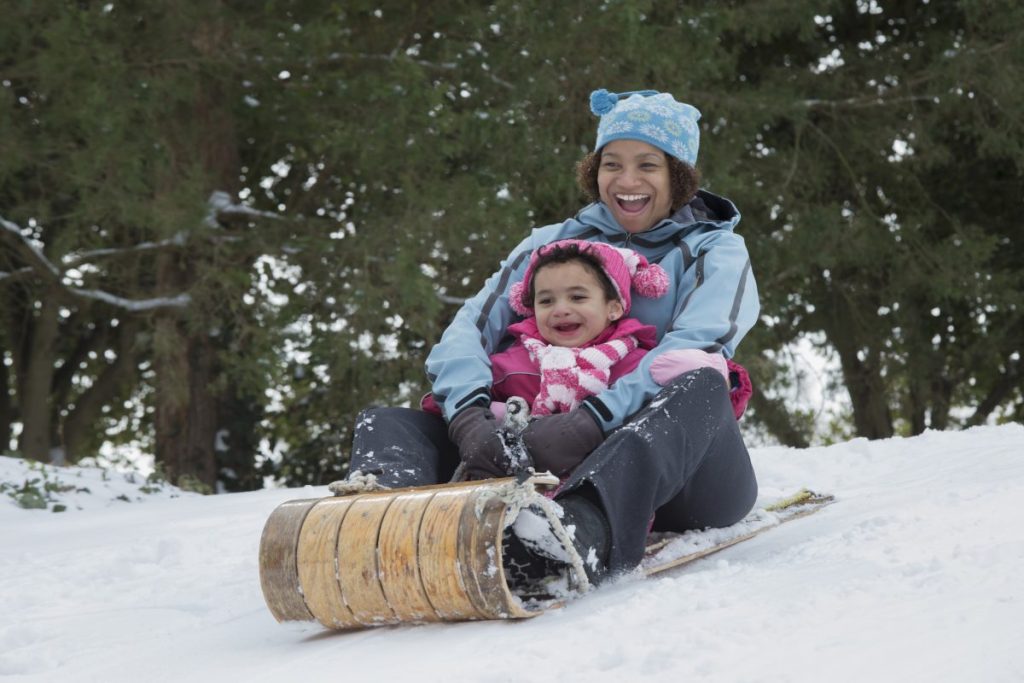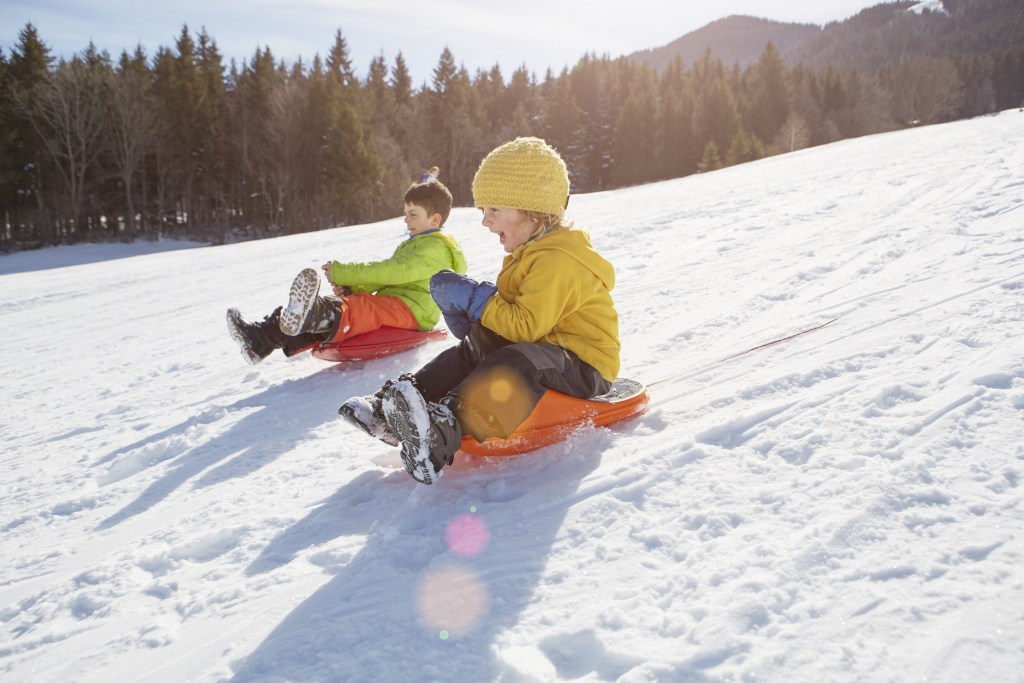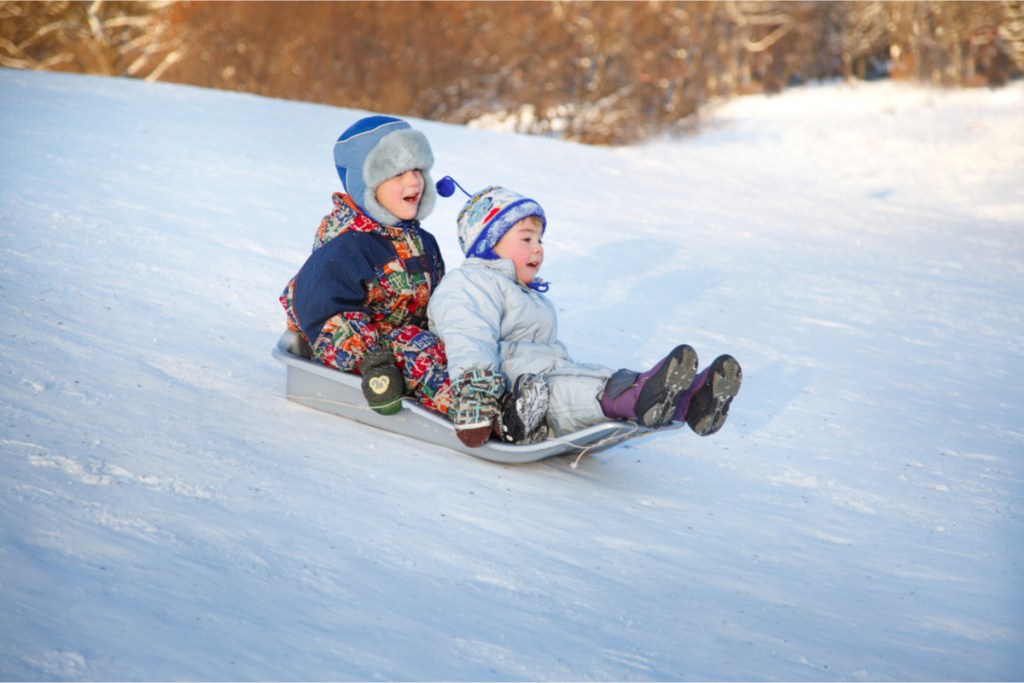One of the best ways to make winter fun for the entire family is to embrace the colder weather and snow and spend playtime outdoors. One of the most enjoyable activities kids love to do during the winter is to go sledding. It also could be one of the most dangerous, too. Sledding safety is important for everyone involved because while sledding is a great way for kids to spend the day outdoors, it’s important to know how to keep everyone safe.
It may be hard to believe, but on average over 20,000 children under the age of 19 are treated in hospitals every year for sledding-related injuries, according to a study done by the Center for Injury Research and Policy of The Research Institute at Nationwide Children’s Hospital. Follow these kid sledding safety tips to make your trip to the family’s favorite hill an enjoyable and safe one.

Get ready the right way
Having the right equipment
Nemours Kids Health notes that proper equipment helps ensure safe sledding. They advise parents to choose a sled that not only has brakes but one that can be steered so your child has maximum control while sledding. Ensure the sled is in good working condition and doesn’t have any cracks or sharp edges.
Those old-school saucers and “krazy karpets” are no longer recommended because of the lack of ability to control them. Children should also always wear a helmet. If you don’t have a hockey helmet or other winter sports helmet, a bicycle helmet is a great option.
Wear the correct clothing
Ensuring your child is dressed appropriately for a day of sledding is extremely important. Children’s Hospital of Pittsburgh states that children should be dressed warmly in hats, heavy boots, and gloves to help avoid any cuts or the risk of frostbite. Have an extra set of dry clothes and gloves for children to change into if they become wet. Encourage them to take a time-out for a bit and warm themselves up indoors.

Where and how to sled
Location is key
Regardless of their age, the location of where you go sledding is very important in ensuring a safe outing. Nationwide Children’s says to avoid areas with trees, fences, light poles, or other stationary obstacles, as well as rocky hills. You’ll also want to avoid any areas that are near roads, highways, or hills that end on roads, like a driveway.
The National Safety Council also adds that you should avoid sledding anywhere near frozen lakes, streams, or ponds. Even if the area you are going to sled in looks safe, an adult should always check first to ensure no hidden obstructions exist and that there is a place for the sled to safely stop.
“Two of the main factors that contribute to sledding-related injuries are the environment and locale,” commented Lara McKenzie, Ph.D., one of the coauthors of the safety study. “To reduce the risk of injury, sledding areas should be clear of trees and other obstacles and should have sufficient run-out areas away from streets. In addition, sledding on streets and highways should be avoided to prevent collisions with motor vehicles and other traffic.”
Form is important
It’s tempting to run and jump headfirst onto a sled and ride it down a hill, but that is definitely not a safe way to go sledding. Sitting or lying down with your feet forward is the safest way to sled, and arms and legs should remain on the sled at all times to avoid injury. Going sledding headfirst raises the risk of serious injury in the event of an accident. CHOP also recommends advising children to roll off a sled that may be going too fast or if they feel unsafe.

Tips for the supervising adults
Sledding safety and supervision
It’s tempting to drop the kids off with a group of friends at the local toboggan hill, but experts say all children, especially those under 12 years old, should be supervised the entire time they are sledding. Should an unfortunate injury occur, having an adult present makes a big difference in getting timely treatment. Adults also curb reckless behavior before it becomes dangerous. Children under the age of 5 should always sled with an adult, while those under 12 should be monitored at all times.
Never sled behind a moving vehicle
Being on a sled pulled by a car or other vehicle is also extremely dangerous and something parents should warn their older children against doing. The Center for Injury Research and Policy’s study noted that more than one-third of injuries that occurred when a sled was being pulled by a vehicle were fractures, and those injuries are on the rise. “Our findings indicate that the prevalence of this activity may be much greater and the practice more common than previously thought. Given the potential for serious injury, children should never ride a sled that is being pulled by a motorized vehicle of any type including all-terrain vehicles (ATVs), snowmobiles, cars, trucks, tractors, motorcycles, dirt bikes, and lawnmowers.”
Follow these kid sledding safety tips to ensure you can enjoy safe sledding all winter long. We want everyone to enjoy that crisp air and take advantage of the best part of the season. Stay safe out there and sled until the hot chocolate is ready to warm everyone up.
Editors' Recommendations
- The best outdoor games for kids – try these fun, classic activities
- 11 fun games kids can play with just pen and paper
- Healthy extracurricular activities kids and teens should explore
- Need a fantastic theme for a fifth birthday party? Consider these
- How to throw the perfect kids’ bowling birthday party




